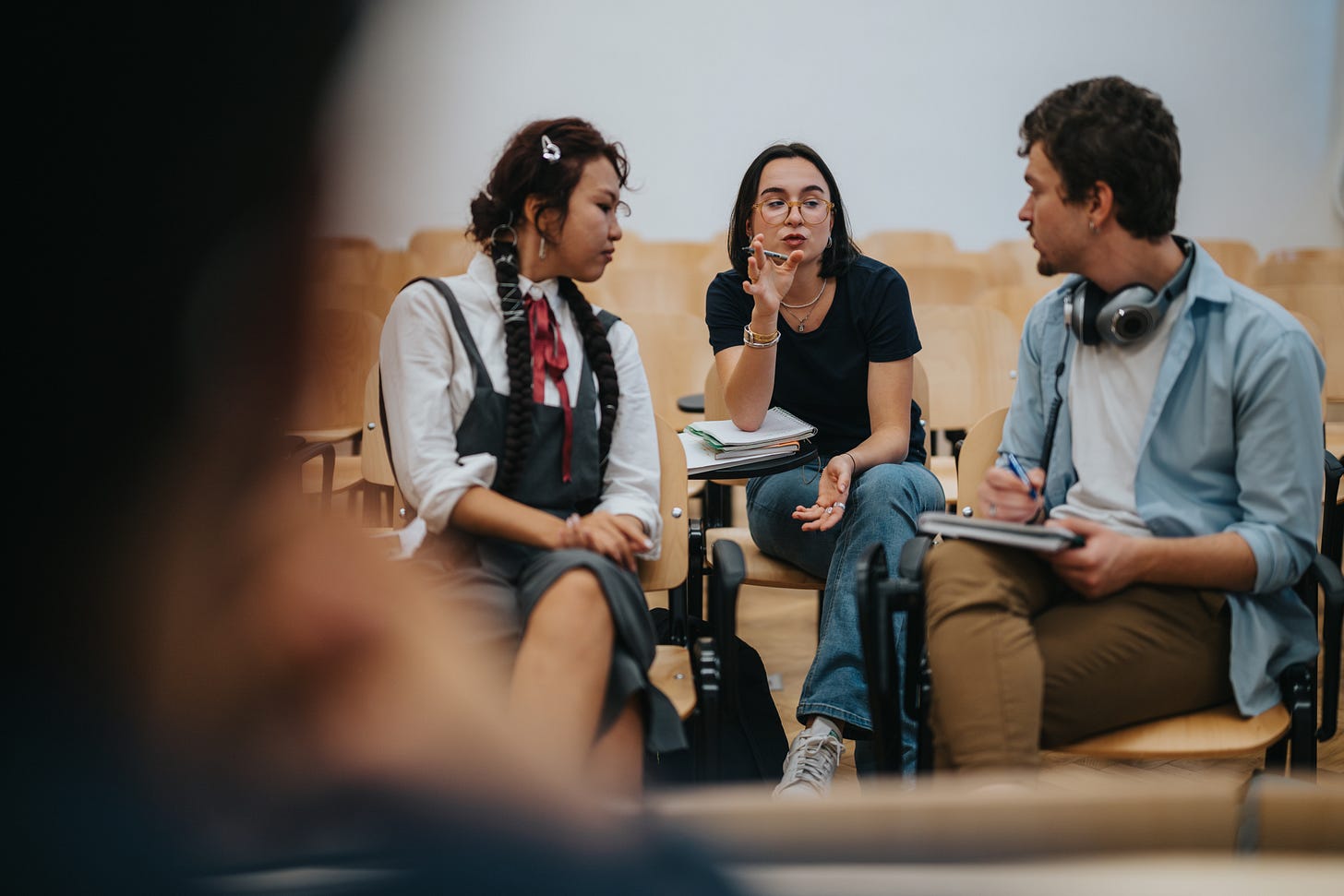From Poetic Performance to Personal Storytelling: Entering the Second Half a Communication-Intensive Performance Course
How scaffolding, trust, and feedback shaped the second half of the semester
We’re moving past the mid-semester point of our C-I in Action series where we follow Dr. Naomi Bennett through her process of teaching a communication-intensive course. This week, we look at what happens when you need to change your plans to facilitate meaningful student engagement and meet the learning goals of the course.
During the second half of the Performance Composition course, students transitioned from poetic language performances into personal narrative work—a shift that required not just a change in writing style, but a deeper level of vulnerability and reflection. In a Communication-Intensive (C-I) course like this one, this is often where the most meaningful application of skills can be seen. That was certainly the case this time.
A Bumpy but Brave Transition
One of the biggest challenges in this stretch was helping students move from poetic, often abstract, performance texts into prose-based personal narratives. Where students had previously written from imagination or metaphor, they were now being asked to root their performances in real-life experience.
C-I connection: This shift emphasized contextual communication and genre awareness, as students learned to adjust their style, structure, and voice to suit a different purpose and audience.
The transition wasn’t seamless—but it was faster than expected. Students adapted faster than they had earlier in the semester, a clear sign that they were beginning to internalize the communication tools and expectations of the course.
Response, Reflection, and Applying New Methods
During this period, students also participated in a lively in-class discussion of Far Halcyon Days, a live performance directed by Travis Brisini in the HopKins Black Box that was a required viewing for the course. To analyze the piece, students used the DIET method—Describe, Interpret, Evaluate, Theorize—a structure they had also practiced when responding to each other’s work.
C-I connection: The use of structured critique frameworks like DIET and Liz Lerman’s Critical Response Process gave students concrete tools for engaging in analytical and audience-aware communication.
What stood out was how students transferred the skills they'd practiced in peer feedback to this external performance. Their discussion and written responses reflected not only engagement with the material but also their growing ability to describe, interpret, and theorize as audience members and meaning-makers.
Building a Culture of Accountability and Care
Despite the usual mid-semester fatigue, the classroom tone remained focused and encouraging. Students came prepared, turned in thoughtful work, and communicated clearly about absences or needs—hallmarks of a supportive, accountable learning environment.
C-I connection: Transparency, consistent feedback, and student ownership are key to C-I pedagogy. Naomi kept students informed with detailed grade updates (even without a formal LMS gradebook), helping them stay on track and aware of their progress.
And while formal structures were in place, the course also allowed for flexibility and experimentation. Students were encouraged to try new things, stumble, reflect, and revise—not just their assignments, but their process. One moment in particular stood out: when a student who had joined the class four weeks late offered feedback that pinpointed what was missing in a peer’s performance—before Naomi could say a word.
Do you have questions about the process of teaching this course as Communication-Intensive? Drop a comment below for Naomi and the CxC Team!
Communication, Community, and Collective Breathing
Each class session began with a collective breathing and focus exercise—a ritual that served both pedagogical and personal purposes.
C-I connection: These moments reinforced meta-communication—the practice of pausing, centering, and becoming aware of one's communicative presence and intention before engaging with others.
By now, students had become a true community. They supported one another’s risks and shared personal experiences with empathy and care. Some even floated the idea of meeting outside class—something Naomi hadn’t heard from previous groups. Though there were occasional moments of playful teasing that prompted reflection, the tone overall was one of genuine connection.
Maybe it’s sticking!
At this point in the semester, Naomi saw evidence that the key tenets of Communication-Intensive teaching had taken root. Students were no longer just learning techniques—they were applying them across genres and situations, supporting one another, and thinking deeply about audience, intention, and meaning.
Even in the exhaustion of this part of the semester, the class felt like a space of energy and growth. Naomi was pleased with the room she was giving them to experiment and grow, and gratified to see the support they were giving each other.
And even when self-care routines faltered, the classroom's grounding presence helped. “The breathing we do at the start of class? It’s as much for me as it is for them.”
C-I Teaching Highlights
Genre shifting: Students practiced transferring communication strategies (e.g., metaphor, description) across writing forms—from poetry to narrative.
Structured response frameworks: CRP and DIET provided tools for critique, applicable to both peer and professional performance.
Audience engagement: Analysis of a live performance reinforced the role of the audience in meaning-making.
Collaborative feedback: Students modeled constructive critique, often before the instructor needed to step in.
Reflective habits: Beginning each class with collective focus supported mindful engagement and presence.
Community building: Trust and empathy made the classroom a space where students could share personal stories and challenge one another thoughtfully.



Read more from this C-I in Action series
Part 1: Meet Communication Studies Professor Dr. Naomi Bennett and learn a little about her Performance Composition C-I course
Part 2: Take a look at some of the initial planning and the first few weeks of the course
Part 3: Exploring the importance of feedback and a willingness to shift plans to ensure successful course outcomes
Part 4: Recognizing a need to change course to facilitate meaningful student engagement, and seeing the outcome of that revision to the plan
Part 5: Explore how scaffolding, trust, and feedback shaped the second half of the semester
Part 6: Students begin building confidence, critique, and connection by putting what they’ve learned into practice
Part 7: Students close the semester balancing challenge and care in the second round of personal narratives


